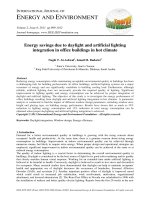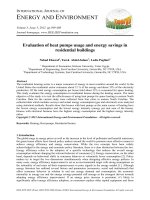Energy savings: building certification
Bạn đang xem bản rút gọn của tài liệu. Xem và tải ngay bản đầy đủ của tài liệu tại đây (237.68 KB, 8 trang )
Building certification
Definition
• A scheme to assess and disclose the environmental
performance of buildings
Annual
energy
consumption
Efficiency of
equipment
Access to
public
transport
Criteria
Building
orientation
Indoor air
quality
How it works
The performance
assessment can be
based on asset
rating and
operational rating
Building energy
certificate indicate
the rating of
building’s energy
performance
The certificate is
published
Strengths of building certification
Reduces negative environmental impact, save
energy
Saves money for building tenants
Increases the marketability of green buildings
Guides further improvement efficiency
Accumulates of data on the environmental
performances of building for policy making
Requires skilled
professionals
Upfront
administrative
Challenges
Developers and
building owners must
pay for building
certificate
Differences
approaches lead to
different rating
Lack of coordination
among certification
Cause confusion
Limited impacts of
voluntary basis
Difficult to obtain
voluntary
participation without
incentives
Implementing strategies
• Complemented with other initiatives such as financial and
building codes
Supplement
Supplement
•
with supportive
measures
Build up
technological
and
administrative
capacity
Require reliable
data and
continued
quality control
• A training strategy can be set at the planning strategy
• Competent assessors should be ensured before launching a building
certification scheme
• Data should be collected in a comprehensive administration system and
should be monitored
• A comprehensive quality-assurance system should be established and
related disciplinary procedures should be prepared
• A certification scheme should be adapted to changes in policy and
legislation.
Examples
Examples
Green rating for Integrated habitat Assessment in India
• Promotes the use of solar energy
• More than 100 buildings already registered for the green rating for integrated habitat certification
Green Building Mark in Singapore
• Aims to green 80% of building across Singapore by meeting this Standard by 2030
• In the end of 2010, 551 new buildings and 65 existing buildings had been certified
Leadership in Energy and Environmental Design in the United States (LEED)
• First developed in 1998
• Green building criteria: use of renewable energy, energy efficiency, electrical demand, water consumption,
access to public transport etc.
• Certified buildings were on 25-30% more energy efficient









